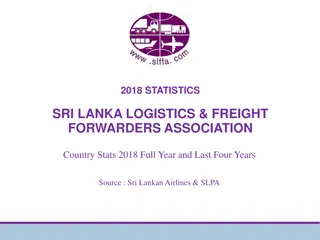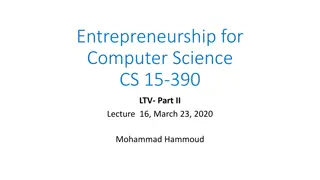
Understanding Unit Economics for Sustainable Ventures
Learn about the importance of Unit Economics in entrepreneurship, focusing on the calculation of Lifetime Value of an Acquired Customer (LTV) and Cost of Customer Acquisition (COCA). Discover the pitfalls of ignoring these crucial metrics through the case study of Pets.com. Dive into the compounding process to grasp the basics of financial concepts essential for calculating LTV.
Download Presentation

Please find below an Image/Link to download the presentation.
The content on the website is provided AS IS for your information and personal use only. It may not be sold, licensed, or shared on other websites without obtaining consent from the author. If you encounter any issues during the download, it is possible that the publisher has removed the file from their server.
You are allowed to download the files provided on this website for personal or commercial use, subject to the condition that they are used lawfully. All files are the property of their respective owners.
The content on the website is provided AS IS for your information and personal use only. It may not be sold, licensed, or shared on other websites without obtaining consent from the author.
E N D
Presentation Transcript
Entrepreneurship for Computer Science CS 15-390 LTV- Part I Lecture 9, February 04, 2018 Mohammad Hammoud
Today Last Session: Business models- Part III Today s Session: Lifetime value of an acquired customer (LTV)- Part I Announcements: PS2 is due on Feb 11 by midnight Quiz 1 is on Feb 18 CP1 is due on Feb 27 by midnight
Unit Economics Is your venture sustainable and attractive from a microeconomic standpoint? Yes, if Lifetime Value of an Acquired Customer (LTV) > Cost of Customer Acquisition (COCA) Rule of thumb: LTV > 3 COCA In other words, yes, if you can acquire customers at a cost that is substantially less than their value to your venture Objective of any business: increase LTV and decrease COCA Failure to do this leads to detrimental outcomes (e.g., Pets.com)
Unit Economics: Pets.com as a Case Study Pets.com Founded in 1998 Concept: sell pets products over the Internet Easily raised millions of dollars from investors Aggressively advertised its website, including a high-profile Super Bowl commercial in 2000 It was losing money with each customer it captured Its management assumed it is a matter of volume (with a huge customer base, the company would become cash-flow positive) Realized late that LTV < COCA In November 2000, it shutdown (300 million dollars of investors money were lost!) $300 million educational lesson: disciplined analysis and intellectual honesty about unit economics are crucial factors for success!
Unit Economics We will first learn how to calculate LTV then COCA Don t worry, entrepreneurial math is much simpler. If the LTV does not equal 3 times the COCA, none of this matters! However, to calculate LTV, we need to build a foundation on some basic finance concepts, namely, compounding and discounting Let us get started!
The Compounding Process Assume you want to deposit $100 in a bank that offers a 10% interest rate that is compounded annually What would be your total amount of money after 3 years? Year Year Year Your Money Your Money Your Money Interest is accrued on interest; hence, the name compounded! 0 0 0 $100 $100 $100 1 1 1 $100 + ($100 0.1) = $100 (1+0.1) = $100 1.1 = $110 $100 + ($100 0.1) = $100 (1+0.1) = $100 1.1 = $110 $100 + ($100 0.1) = $100 (1+0.1) = $100 1.1 = $110 $110 1.1 = ($100 1.1) 1.1 = $100 1.12 = $121 $110 1.1 = ($100 1.1) 1.1 = $100 1.12 = $121 $110 1.1 = ($100 1.1) 1.1 = $100 1.12 = $121 2 2 2 $121 1.1 = (($100 1.1) 1.1) 1.1 = $100 1.13 = 133.1 $121 1.1 = (($100 1.1) 1.1) 1.1 = $100 1.13 = 133.1 $121 1.1 = (($100 1.1) 1.1) 1.1 = $100 1.13 = 133.1 3 3 3
The Compounding Process Assume you want to deposit $100 in a bank that offers a 10% interest rate that is compounded annually What would be your total amount of money after 3 years? Year Year Year Your Money Your Money Your Money 0 0 0 $100 $100 $100 1 1 1 $100 + ($100 0.1) = $100 (1+0.1) = $100 1.1 = $110 $100 + ($100 0.1) = $100 (1+0.1) = $100 1.1 = $110 $100 + ($100 0.1) = $100 (1+0.1) = $100 1.1 = $110 $110 1.1 = ($100 1.1) 1.1 = $100 1.12 = $121 $110 1.1 = ($100 1.1) 1.1 = $100 1.12 = $121 $110 1.1 = ($100 1.1) 1.1 = $100 1.12 = $121 2 2 2 $121 1.1 = (($100 1.1) 1.1) 1.1 = $100 1.13 = 133.1 $121 1.1 = (($100 1.1) 1.1) 1.1 = $100 1.13 = 133.1 $121 1.1 = (($100 1.1) 1.1) 1.1 = $100 1.13 = 133.1 3 3 3
The Compounding Process How long would it take to double your $100, assuming 10% interest rate? $100 1.1n= $200 1.1n= $2 n = log1.1 2 = log 2 / log 1.1 = 7.272 Another way to calculate this quickly is to divide 72 by 10 72/10 = 7.2, which is very close to 7.272 calculated above This is referred to as the rule of 72 , which entails dividing 72 by the given interest rate How long would it take to double your $233, assuming 7% interest rate? 72/7 = 10.28 years (or log 2 / log 1.07 = 10.244 years)
The Compounding Process The trick of period and the magical e Compound Semi- annually Compound Annually Compound Daily Compound Monthly $1 Loan $1 Loan $1 Loan $1 Loan 100%/365 interest rate 100%/12 interest rate 1/365 Y 1/12 Y 50% 1/2 Y interest rate 100% 1 1.00273= $1.00273 . . . 1 1.083= $1.083 . . . 1 YEAR interest rate 1 1.5= $1.5 50% 1/2 Y interest rate 100%/365 interest rate 100%/12 interest rate 1/12 Y 1/365 Y 1.5 1.5= 1 1.52 = $2.25 1 1.00273365 = $2.7 1 1.08312= $2.6 1 2= $2 1 (1+1/2)2 = $2.25 1 (1+1/12)12 = $2.613 1 (1+1/1)1 = $2 Interest Rate 1 (1+1/365)365 = $2.714 = e Period
The Compounding Process The trick of period and the magical e Compound Semi- annually Compound Annually Compound Daily Compound Monthly $1 Loan $1 Loan $1 Loan $1 Loan 100%/365 interest rate 100%/12 interest rate 1/365 Y 1/12 Y Most banks compound interest monthly or daily (this is referred to as continuous compounding) 50% 1/2 Y interest rate 100% 1 1.00273= $1.00273 . . . 1 1.083= $1.083 . . . 1 YEAR interest rate 1 1.5= $1.5 50% 1/2 Y interest rate 100%/365 interest rate 100%/12 interest rate 1/12 Y 1/365 Y 1.5 1.5= 1 1.52 = $2.25 1 1.00273365 = $2.7 1 1.08312= $2.6 1 2= $2 1 (1+1/2)2 = $2.25 1 (1+1/12)12 = $2.613 1 (1+1/1)1 = $2 Interest Rate 1 (1+1/365)365 = $2.714 = e Period
The Discounting Process Assume someone proposes to give you $100 today or $110 in a year Which option would you select, assuming 5% risk-free interest rate? Option 1 Option 2 timeline Today (or Year 0) $100 5% risk-free interest rate, compounded annually Year 1 $110 $100 1.05 = $105
The Discounting Process Assume someone proposes to give you $100 today or $110 in a year Which option would you select, assuming 5% risk-free interest rate? Option 1 Option 2 timeline Today (or Year 0) $110/1.05 = $104.76 $100 5% discount rate, discounted annually Year 1 $110
The Discounting Process Assume someone proposes to give you $100 today or $110 in a year Which option would you select, assuming 5% risk-free interest rate? Option 1 Option 2 Present Value of $110 timeline Today (or Year 0) $110/1.05 = $104.76 $100 5% risk-free interest rate, compounded annually 5% discount rate, discounted annually Future Value of $100 Year 1 $110 $100 1.05 = $105 Discounting is the opposite of compounding; In compounding you multiply by (1 + interest rate), but in discounting you divide by (1 + discount rate).
The Discounting Process Assume someone proposes to give you $100 today or $110 in a year Which option would you select, assuming 5% risk-free interest rate? Option 1 Option 2 Present Value of $110 timeline Today (or Year 0) $110/1.05 = $104.76 $100 5% risk-free interest rate, compounded annually 5% discount rate, discounted annually Future Value of $100 Year 1 $110 $100 1.05 = $105 The Present Value concept in one of the fundamental and most useful concepts in finance!
The Discounting Process Assume someone proposes to give you $100 today, $110 in 2 years, or ($30 today, $30 in a year, and $40 in 2 years) Which option would you select, assuming 5% discountrate? Option 2 Option 1 Option 3 $110/1.052 = $99.77 + $40/1.052 = 94.85 $100 + $30/1.05 Year 0 $30 Year 1 $40/1.05 $30 $110/1.05 $40 $110 Year 2
The Discounting Process Assume someone proposes to give you $100 today, $110 in 2 years, or ($30 today, $30 in a year, and $40 in 2 years) Which option would you select, assuming 4% discount rate? Option 2 Option 1 Option 3 $110/1.042 = $101.7 + $40/1.042 = 95.82 $100 + $30/1.04 Year 0 $30 Year 1 $40/1.04 $30 $110/1.04 $40 $110 Year 2 As the discount rate decreases, the present value increases and vice versa.
Present Value Present value is the result of discounting future value to the present In general, its formula can be stated as follows: PV = FV/(1+r)n, where PV = Present Value FV = Future Value r = Discount Rate (or rate of return) n = Number of Periods, which could be in years, months, weeks, etc. Related to the concept of the present value is the net present value
Net Present Value Assume you want to invest in a business $10,000 Can you pay off this investment in 3 years, assuming a discount rate of 5%? Cash Inflow Cash Inflow Cash Inflow Cash Outflow $10,000 Year 0 $3,000 Year 1 There is a Time Value of Money (e.g., $10 today worth more than $10 in a year) because of inflation and earnings that could be potentially made using the money during the intervening time; hence, discount! Year 2 $4,000 Year 3 $5,000
Net Present Value Assume you want to invest in a business $10,000 Can you pay off this investment in 3 years, assuming a discount rate of 5%? Cash Inflow Cash Inflow Cash Inflow Cash Outflow $4,000/1.052 = $3628.11 $5,000/1.053 = $4319.18 $10,000 $3,000/1.05 = $2857.14 Year 0 $3,000 Year 1 Year 2 $4,000 Year 3 $5,000
Net Present Value Assume you want to invest in a business $10,000 Can you pay off this investment in 3 years, assuming a discount rate of 5%? ???? ??????? Cash Inflow Cash Inflow Cash Inflow Cash Outflow $3628.11 $10804.44 $4319.18 $10,000 $2857.14 Year 0 $3,000 Year 1 $4,000 Year 2 $5,000 Year 3
Net Present Value Assume you want to invest in a business $10,000 Can you pay off this investment in 3 years, assuming a discount rate of 5%? ( ???? ???????) ???? ??????? ???? ??????? Cash Outflow $10,000 $10804.44 $10804.44 $10,000 = 804.44 Year 0 YES, you can pay off your investment in 3 years Year 1 Year 2 Year 3
Net Present Value Net Present Value (NPV) is a capital budgeting tool that can be used to analyze the profitability of a projected investment or project NPV = PV(All Cash Inflows) PV(Cash Outflow) If NPV > 0 accept; otherwise, reject! ?? ? More formally, NPV = ?=1 N = Number of time periods Cn = Net cash inflow during period n C0 = Net cash outflow (or total initial investment) r = Discount rate (1+?)? ?0, where
Next Class Calculate the Lifetime Value (LTV) of an Acquired Customer






















